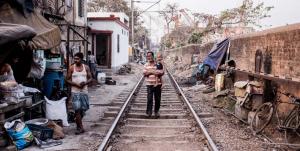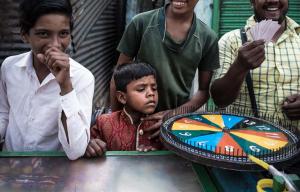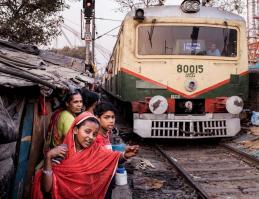Calcutta really exists
Publish date 27-05-2022

Our society has excluded them and they have reorganized themselves creating a parallel world made up of houses, jobs, services and everything that has been closed to them outside the slum.
It had been a long time that I wanted to visit Calcutta, the city with twenty million inhabitants, difficult for me to digest as I live in a small town in the province of Turin, a number that is diluted a little if I think of the billion Indians distributed throughout the Village.
It was enough to enter the train station to understand that this humanity is a river in flood, that you feel it, it is noisy, colorful and always in motion.
At rush hour, the trains that stop are literally assaulted by passengers who also enter through the windows in the wagons in order to grab a seat.
The third largest city in India by number of inhabitants after Mumbai and New Delhi, it experienced a period of great splendor around the mid-1700s when it became the capital of the East India Company under the English protectorate.
Today, to testify that historical period, only the monuments remain. Victoria Memorial, Marble Palace, Indian Museum, Tagore House and Saint Paul's Cathedral, all buildings steeped in history, but it is when I walk the 665 meters of Howrah Bridge that my heart slows down.
For the first time, I enter a slum and I have the feeling of having been catapulted into another world.
It seems strange, but not impossible, that inside a slum there could be a shoemaker, a dentist, a mechanic, and even a doctor who transformed his shack into a pharmacy complete with medicines.
A kid who must have been around ten years old invites me to bet on a wheel of fortune that I honestly never imagined finding right here.
There are over 3 thousand crumbling slums in Calcutta alone where thousands of people live, mainly emigrated from the countryside and arrived in the city in search of work.
I had heard of them, I had read books like City of Joy and Shantaram, I had seen them in films like The Millionaire, but getting into them in person is quite another thing. The first reaction is not fear, as I would have imagined, but rather the amazement of seeing with my own eyes that all this really exists.
Poverty is perceptible everywhere, makeshift huts made of rags, pieces of plastic, wooden planks and cardboard, some crumbling brick buildings forming a labyrinth where people move apparently organized.
And it is this oxymoron of ordered chaos that strikes me. A hellish circle where men, women and children seem to lead a normal life.
I wonder how it is possible to survive here.
Hari, my Indian friend who guides me, explains that for some it is the only possible alternative.
They belong to the lowest caste and have been on the fringes of society since they came into the world, they know there is no chance to change their destiny in this life and they just accept it.
Our society has excluded them and they have reorganized themselves, creating a parallel world made up of houses, jobs, services and everything that has been closed to them outside the slum.
So it seems strange, but not impossible, that inside a slum there could be a shoemaker, a dentist, a mechanic, and even a doctor who has transformed his shack into a pharmacy complete with medicines.
The shacks are everywhere it is possible to build them, even close to the train tracks where the rhythm of life is marked by the passage of the locomotives.
A kid who must have been around ten years old invites me to bet on a wheel of fortune that I honestly never imagined finding right here and who knows what else there will still be if I had the courage to enter the bowels of the slum. The shacks are everywhere it is possible to build them, even close to the train tracks where the rhythm of life is marked by the passage of the locomotives.
One of the most populous metropolises in India has nearly 3,000 slums in its belly, spread over an area of over 200 square kilometers. Thousands of neighborhoods populated by a humanity without rights, suffocated by rampant misery, which for the moment seems to find no way out, even though many humanitarian associations are doing their best.
Photos and texts by Roberto Cristaudo
NPEYES February 2022

















